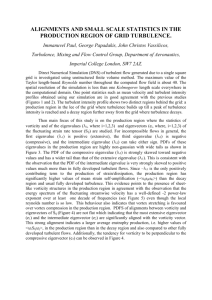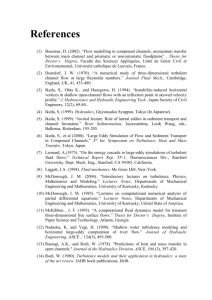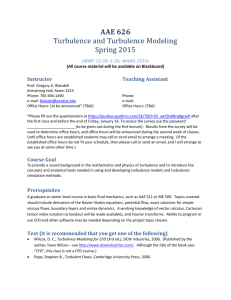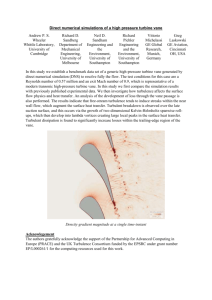Метод прямого численного моделирования крупномасштабной
advertisement
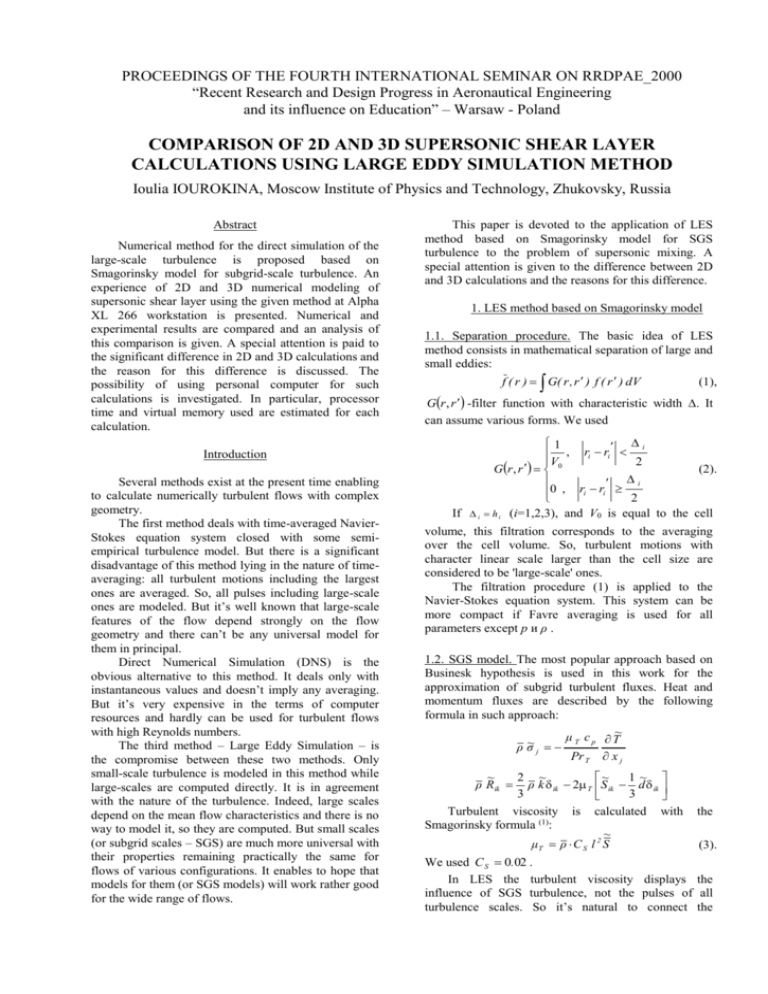
PROCEEDINGS OF THE FOURTH INTERNATIONAL SEMINAR ON RRDPAE_2000 “Recent Research and Design Progress in Aeronautical Engineering and its influence on Education” – Warsaw - Poland COMPARISON OF 2D AND 3D SUPERSONIC SHEAR LAYER CALCULATIONS USING LARGE EDDY SIMULATION METHOD Ioulia IOUROKINA, Moscow Institute of Physics and Technology, Zhukovsky, Russia Abstract Numerical method for the direct simulation of the large-scale turbulence is proposed based on Smagorinsky model for subgrid-scale turbulence. An experience of 2D and 3D numerical modeling of supersonic shear layer using the given method at Alpha XL 266 workstation is presented. Numerical and experimental results are compared and an analysis of this comparison is given. A special attention is paid to the significant difference in 2D and 3D calculations and the reason for this difference is discussed. The possibility of using personal computer for such calculations is investigated. In particular, processor time and virtual memory used are estimated for each calculation. Introduction Several methods exist at the present time enabling to calculate numerically turbulent flows with complex geometry. The first method deals with time-averaged NavierStokes equation system closed with some semiempirical turbulence model. But there is a significant disadvantage of this method lying in the nature of timeaveraging: all turbulent motions including the largest ones are averaged. So, all pulses including large-scale ones are modeled. But it’s well known that large-scale features of the flow depend strongly on the flow geometry and there can’t be any universal model for them in principal. Direct Numerical Simulation (DNS) is the obvious alternative to this method. It deals only with instantaneous values and doesn’t imply any averaging. But it’s very expensive in the terms of computer resources and hardly can be used for turbulent flows with high Reynolds numbers. The third method – Large Eddy Simulation – is the compromise between these two methods. Only small-scale turbulence is modeled in this method while large-scales are computed directly. It is in agreement with the nature of the turbulence. Indeed, large scales depend on the mean flow characteristics and there is no way to model it, so they are computed. But small scales (or subgrid scales – SGS) are much more universal with their properties remaining practically the same for flows of various configurations. It enables to hope that models for them (or SGS models) will work rather good for the wide range of flows. This paper is devoted to the application of LES method based on Smagorinsky model for SGS turbulence to the problem of supersonic mixing. A special attention is given to the difference between 2D and 3D calculations and the reasons for this difference. 1. LES method based on Smagorinsky model 1.1. Separation procedure. The basic idea of LES method consists in mathematical separation of large and small eddies: (1), f ( r ) G( r , r ) f ( r ) dV Gr , r -filter function with characteristic width . It can assume various forms. We used 1 i , ri ri 2 V G r , r 0 (2). i 0 , ri ri 2 If i h i (i=1,2,3), and V0 is equal to the cell volume, this filtration corresponds to the averaging over the cell volume. So, turbulent motions with character linear scale larger than the cell size are considered to be 'large-scale' ones. The filtration procedure (1) is applied to the Navier-Stokes equation system. This system can be more compact if Favre averaging is used for all parameters except p и ρ . 1.2. SGS model. The most popular approach based on Businesk hypothesis is used in this work for the approximation of subgrid turbulent fluxes. Heat and momentum fluxes are described by the following formula in such approach: μ T c p T~ ~ ρσj Pr T x j 2 ~ 1~ ~ ~ ρ Rik ρ k ik 2 T S ik d ik 3 3 Turbulent viscosity is calculated with Smagorinsky formula (1): ~ μT ρ C S l 2 S the (3). We used C S 0.02 . In LES the turbulent viscosity displays the influence of SGS turbulence, not the pulses of all turbulence scales. So it’s natural to connect the turbulent viscosity with the SGS scale, which has the same magnitude as the grid size when the filter function (2) is used. Therefore we calculate the linear scale l in (3) as follows l min h x , h y , h z . Algebraic method for modeling the SGS kinetic ~ energy k based on universal balance hypothesis is proposed in this work. If small (SGS) eddies are supposed to be in the range of universal balance then the SGS turbulence has the quasi-steady structure. It signifies that the ratio of the turbulence production to P its dissipation ~ const . These considerations lead ρ ~ to the following formula for k in the result: 2 R, t R0,0exp 2 2 t 2 , where 0 - vortex center position, - radiusvector, defining the position of the given point with respect to the vortex center, R, t f , t f 0,0 , - some characteristic scale defining the rate of decline in influence of the given vortex, - characteristic frequency of pulses. Large vortexes are taken to be located uniformly with the interval /2 in space at the given work. Generally, the scale isn’t connected with the cell size of the computational grid (Fig.1). 2 μT ~ . k C ρl The value of the constant C is calculated from the paper (3) and constitutes C 46 . Such approach was used earlier in (2) for the estimation of time-averaged turbulence kinetic energy k. 1.3. Numerical method. We used the following numerical method in our calculations (4): explicit monotone Godunov-Kolgan-Rodionov scheme (5-8) for the approximation of convective fluxes. It has the 2nd order of approximation for all variables. Original iterative non-linearised solution of the Riemann problem is used. The principle of the minimal values of derivatives is used to achieve the 2nd order of approximation in space (8). This principle is the Russian analogue of the widely used TVD principle (9). The 2nd order of approximation in time is achieved with the “predictor-corrector” procedure; explicit 2nd order approximation for the diffusive fluxes (modifies central-difference scheme) (4). 1.4. The way of setting random initial and boundary conditions. Parameters calculated in each cell are instant random values in the numerical simulation of large-scale turbulence. They oscillate over the mean values with some definite law. Mean values can be obtained from the calculation of time-averaged NavierStokes equation system. We assumed that pulses were distributed in time with the Gauss law with some dispersion. We consider the way of determination of this dispersion in the next part of this section. Instant value of large-scale field parameter in each point of space can be represented as the sum of its time~ ~ ~ averaged value and the pulsation: f f f . Let's consider large-scale turbulence as the collection of large vortexes interacting with each other. We take that the position, size and intensity of these vortexes are known at the given moment. The influence of each vortex on the given point is determined by the correlation FIG. 1. The structure of boundary disturbances 2. Calculation of the test task with LES method 2.1. The formulation of the problem. It’s necessary to check the adequacy of the proposed method on simple test problems with known experimental or theoretical results before applying it to 3D turbulent flows of the complex geometry. The problem of mixing of two parallel supersonic air flows was chosen as the test task. The scheme of the flow is presented at the Fig.2. FIG. 2. Flat supersonic mixing layer One of the most important characteristic of the mixing layer is its growth rate db/dx where b is the mixing layer width. The following regime was chosen: The upper stream: M=2, T=163 K; The lower stream: М=1.4, T=214 K; P=50 кПа for both streams. Compressibility effects can be neglected at such regime and the generalization of experimental data leads to the following formula for the growth rate of the mixing layer (10): 1 r 1 s db (4). 0.165 dx 21 r s Here r u 2 u1 , s 2 1 . So the growth rate for the considered regime must be db / dx ~ 0.018 . 2.2. Boundary conditions. The most part of calculations by LES method is quasi-2D in this work i.e. only one cell is given at z direction. The cell size along z-axis h z - is the same for all cells and taken as the minimal value h x , h у for all cells. Non-stationary random disturbances were imposed on the parameters of undisturbed flows at the left boundary. New values of disturbances are set at each time step. Turbulent Mach number МТ is taken as 0.3 for both flows. Disturbances of all parameters constitute approximately 10% from its mean value. Linear extrapolation of flow parameters is used at the right boundary. Parameters of undisturbed flows or mirror reflection of parameters are set at the upper and lower boundaries depending on the computational region configuration. 2.3. Computation results. The main problem in using LES method consists in necessity to find the structure and cell size for the computational grid allowing SGS pulses to lie in the range of universal balance. The grid must be as fine as possible in the region of the initiation of the turbulence in order to describe the development of turbulence in detail. This region is near the tangential discontinuity. The grid must be however much coarser in the layer where the turbulence is quite developed. Therefore the uniform grid is not the right choice: one can achieve better results with the same number of cells if they are widened with the distance from the surface of tangential discontinuity. Computational grid configuration chosen in the result of acquaintance with the work (11) is shown in Fig.3. H 0 1 / 25 H1 with the uniform grid containing N min cells in the transverse direction (the layer CDIJ in Fig.3) is located along the longitudinal axis of symmetry in order to describe in details the origin of the instability. Variable grid containing N 1 cells in the transverse direction is made in the upper and lower layers (DEHI and BCJK). “Buffer” subregions EFGH and ABKL are added to the rectangular BEHK. Their role is to preclude the reflecting of the small disturbances due to the mixing layer from computational region boundaries. The computational region length is L=1м. The number of cells in the longitudinal direction is N x 600 . N min 8 cells in the layer CDIJ, N1 12 cells in the layers DEHI and BCJK. N buf 10 cells in “buffer” zones. Two turbulent vortexes are given at the section CD adjacent to the interface between two mixing flows (Fig.3) to initiate the development of Helvin-Helmholtz instability. Undisturbed flow parameters are set at the left boundary out of the section CD. The surface of discontinuity begins to oscillate after 3-4 thousand time steps and the region of nonstationary flow with large vorticity is formed between two mixing flows (Fig.4) over the some time (approximately 20 thousand steps after the beginning of the calculation). FIG. 4. Instantaneous field of Mach-Number 2.4. Investigation of time-averaged flow. All available experimental data for the mixing layers deal with timeaveraged flow characteristics. Therefore it's necessary to average non-stationary flow field in time in order to compare our calculations with these experimental data. Time-averaged flow parameters are determined by t T / 2 1 a(r, ) d, where the time the formula a (r ) T t T / 2 FIG. 3. Structure of non-uniform computational grid The basic part of the computational region where the mixing layer are to be obtained is the rectangular (BEHK in Fig.3) with the length L and width The layer of width H1 2L db dxtheory . averaging interval T must be much larger than the character time of energy-containing turbulent motions. It was shown in our calculations that minimal time averaging interval T must be about 5 thousands time steps. We used averaging interval twice as big as the minimal one – 10 thousand time steps. Steady flow averaged by such a way is shown in the Fig. 5. It’s seen that developed shear layer is formed in the computational region. than in the reality even after the full elimination of SGS turbulence. It means that one of the components of the “total” turbulent viscosity – large-scale turbulence – isn’t described rightly. 2.0E-2 Cs = Co Cs = Co/1.5 FIG. 5. Time-averaged field of Mach number 1.6E-2 Growth rate and width are important characteristics of the shear layer as it was mentioned above. Therefore these parameters will be used further for the comparison of the results of various calculations between each other and with experimental data. Comparison of computational and experimental distribution of the shear layer width is shown in fig.6. It’s seen that the growth rate of the shear layer at the self-similar section is equal d b d x ~ 0.03 , which is approximately 1.5 times greater than the value predicted by the formula (4). b (x), m Cs = 0 Experiment 1.2E-2 8.0E-3 4.0E-3 0.0E+0 0.0 0.2 0.4 0.6 0.8 1.0 x, m FIG. 7. Calculations for various values of C S . 2.0E-2 b (x), m 1.6E-2 1.2E-2 8.0E-3 4.0E-3 0.0E+0 0.0 0.2 0.4 0.6 0.8 1.0 x, m Calculation Approximation curve: b(x)~0.03 x Experimental curve: b(x)~0.018 x FIG. 6. Comparison of computational and experimental dependencies b(x) To estimate the contribution of the SGS turbulence we made the calculation for the case C S 0 , i.e. excluded SGS turbulence at all and switched to the inviscid flow model described by Euler system of equations. Only large-scale turbulence connected with Helvin-Helmholtz instability and generated by non-stationary disturbances in the boundary conditions left in the result. The mixing layer growth rate decreased 1.2 times because of elimination of additional mixing due to SGS turbulence (Fig.7). On the one hand, it shows that SGS turbulence still plays the significant role in our calculations. On the other hand, the shear layer growth rate has the larger value There are two possible reasons for improper description of the large-scale turbulence. The 1st reason: computational grid is too coarse. As the result we model only the biggest motions generated by Helvin-Helmholtz instability. But they are not the real turbulence; actual large-scale turbulence must contain several levels of vortexes. Only one level can be found in calculations described above (see Mach number isolines in Fig. 8,a). The absence of smaller levels can lead to the accumulation of turbulent energy in large eddies. The result of the energy accumulation in the large eddies will be the overvaluation of the intensity of turbulent diffusion and, respectively, the shear layer growth rate. The grid must be fined further in order to achieve the simulation of smaller level eddies. Unfortunately, the possibilities of the grid refining are quite limited if modern personal computers are used for calculations. For example, calculations with the length of the computational region L=1 m require about 50 Mb of the virtual memory and one time step is equal to approximately 0.5 min for the workstation Alpha XL266. No less that 20 thousand time steps or 7 days of ceaseless calculation are necessary for the timeaveraged flow to become steady. But nevertheless the calculation with the following computational grid parameters was made: L=1 м, Nx=48, Nmin=16, N1=1200, H0= 8 10 4 m. “Buffer” subregions were removed with the aim of the economy of computational resources. Such a problem requires 190 Mb of the virtual memory and each time has more than 2 min duration. Moreover, h2 time step limitation ( ) became stronger 4 because of the cell size diminution, i.e. more number of steps are now required to obtain the developed flow growth rate hasn’t changed practically. Perhaps, it means that the grid is still too coarse resulting in the representation of the insufficient number of eddy motion levels and incorrect description of the turbulent energy transition trough the cascade of eddies. We transit now to the second possible reason for improper large-scale turbulence representation. pattern. One can see the results of this calculation and the comparison with the calculation using the primary grid in Fig.8. Instant Mach number isolines with the step 0.01 are shown in this figure. а) b) FIG.8. Comparison of the instant field of Mach number for the primary and refined grids a) Primary grid b) Refined grid It can be seen that we caught only one level of eddies at the primary grid. The second level appears at the 4 times finer grid and the fist level eddies are resolved more precisely. The comparison of shear layer width for these two configurations is shown in Fig.9. 1.6E-2 Primary grid Refined grid b (x), m 1.2E-2 8.0E-3 4.0E-3 0.0E+0 0.0 0.1 0.2 0.3 0.4 0.5 0.6 x, m FIG. 9.Calculations for two grid configurations The basic difference is in the fact that sharp growth of the shear layer begins now at the lower value of x (x~0.1 m, not x~0.4 m). It’s evident since the value of turbulent viscosity is smaller in each cell when the grid is finer. Therefore eddies closer to the beginning of mixing of the flow smeared earlier by the turbulent viscosity start to develop now. But the shear layer The 2nd reason: calculations were two-dimensional (computational region contained only one cell along the z-axis). It’s known that properties of the turbulence differ to the great extent in 2D and 3D flows (12-14). Characteristic feature of 2D turbulence is conservation of not only energy, but enstrophy (mean square vorticity) during the interaction of turbulent eddies. It’s shown in paper (14) that enstrophy flux in the balance range must be directed from the large eddies to the small ones. Then it follows from the conservation laws that the energy must be transmitted trough the cascade of eddies in the opposite direction. So, energy is accumulated in the large scales in 2D turbulence. Oversized value of the shear layer growth can be the result of such accumulation that is observed in our calculation. 3D calculation of the given problem was made to check this supposition. Computational region was in the form of the rectangular parallelepiped. Its projections on the plane (x, y) coincided with the rectangular BEHK (Fig.3), i.e. with the computational region configuration without "buffer" subregions used in 2D calculations. The width of the parallelepiped along the z-axis was equal to its height ( H 1 ) with 16 uniform cells given along it. The following boundary conditions was set: 25 eddies was given along the z-axis above and below the discontinuity surface at the left boundary of the layer with small cells (values of parameters in the center of cells was determined using the linear extrapolation). Supersonic inflow condition was set at the remaining part of the left boundary; mirror reflection condition at the upper, lower and lateral boundaries. The calculation was made at the limit of possibilities of available PC (Alpha XL 266 workstation). The task occupied 190 Mb of the virtual memory. Each time step required about 5 minutes of the processor time with 30000 time steps necessary for obtaining the stationary averaged flow. Calculation results are shown in the Fig.10. One can see rather good agreement with the experimental data. So, incorrect value of the shear layer growth rate obtained in calculations described above was really connected with two-dimensional problem setting. 2.0E-2 References 1. 1.6E-2 b (x), m 2. 1.2E-2 3. 8.0E-3 4.0E-3 4. 0.0E+0 0.0 0.2 0.4 0.6 0.8 1.0 x, m 2D calculation 5. 3D calculation Experimental profile 6. FIG.10. Comparison of curves b(x) for 2D and 3D calculations The following can be recommended for the further improvement of the calculation results: a) to use more detailed grid in the vicinity of the shear layer; b) to use more elaborated SGS model. Certainly, all these improvements will require certain computational resources, which are beyond the possibilities of modern personal computers. So, we are forced to accept that it’s still impossible to make turbulent flow calculations using LES method at PCs. 7. 8. 9. Conclusions 1. 2. 3. Numerical method for direct modeling of largescale turbulence based on Smagorinsky model is proposed. The method contains a number of original elements: 1) the way of direct modeling of SGS turbulence; 2) an algorithm for setting random boundary conditions with the account of neighbor vortexes. 2D and 3D calculations of the test task about turbulent mixing of two supersonic flows were performed using this method. Comparison of 2D and 3D numerical results with the experimental ones was made. 2D calculations proved to be rather inaccurate while 3D results displayed good correspondence with the experiment. This comparison and theoretical insight into the nature of 2D and 3D turbulence demonstrate the evidence of the necessity for LES calculation to be essentially three-dimensional. Possibilities of modern Personal Computers are still insufficient for performing turbulent flow calculations using LES method. 10. 11. 12. 13. 14. Smagorinsky, J. Mon. Weather Rev., Vol.91, p.99, 1963 Иевлев В.М. Турбулентное движение высокотемпературных сплошных сред. М., “Наука”, 1975. Morris, P.J., Qunzhen Wang, Long, L.N. & Lockard, P.D. Numerical Predictions of High Speed Jet Noise. The Pennsylvania State University. American Institute of Aeronautics and Astronautics, pp. 1-13. S.Bosniakov, S.Fonov, V.Jitenev, A.Shenkin, V.Vlasenko, N.Yatskevich. Method for Noise Suppressing Nozzle calculation and first results of its implementation. Propulsion and power, Vol.14, No.1, pp.101-109, 1998. Годунов С.К., Забродин А.В., Иванов М.Я., Крайко А.Н., Прокопов Г.П. Численное решение многомерных задач газовой динамики. М., "Наука", 1976. Колган В.П. Применение принципа минимальных значений производной к построению конечно-разностной схемы для расчета разрывных решений газовой динамики. "Ученые записки ЦАГИ", т.3, №6, 1972. Родионов А.В. Монотонная схема 2-го порядка аппроксимации для сквозного расчета неравновесных течений. Журнал вычислительной математики и математической физики, т.27, №4, 1987. Родионов А.В. Повышение порядка аппроксимации схемы С.К.Годунова. Журнал вычислительной математики и математической физики, т.27, №12, 1987. Наrten, A. High resolution schemes for hyperbolic conservation laws. Journal of Computational Physics, Vol.49, №3, 1983. Goebel S.G., Dutton J.C. Velocity measurements of compressible, turbulent mixing layers. AIAA90-0709, 1990. Oran, E.S., Boris, J.P. Numerical simulations of asymmetric mixing in planar shear flows. Journal of Fluid Mechanics, vol.165, pp. 201-220, 1986 Монин А.С. Турбулентность и микроструктура в океане. Успехи физических наук, т.109, вып.2, стр.333-354, 1973 Монин А.С, Жихарев Г.М. Океанские вихри. Успехи физических наук, т.160, вып.5, стр. 147. Kraichnan, R.H. Inertial range in two-dimensional turbulence. Phys.Fluids, Vol.10, pp.1417-1423, 1967.
